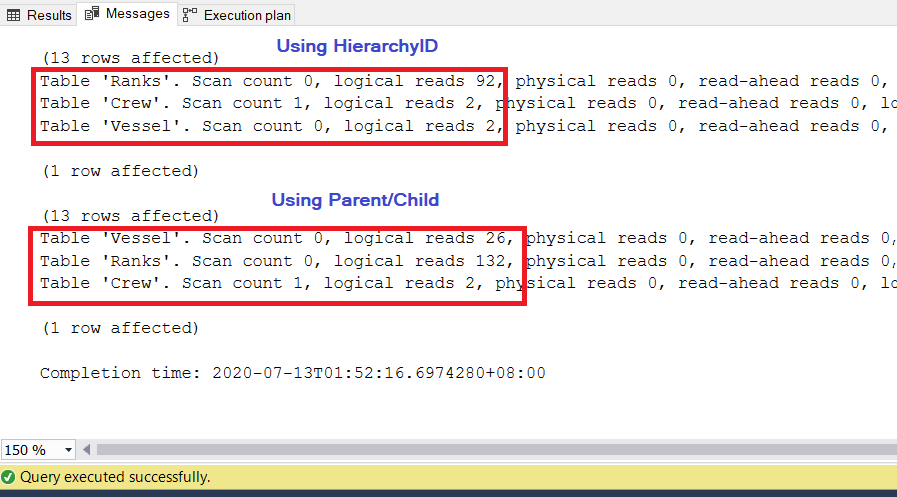

- Excel query table with hierarchyid data type install#
- Excel query table with hierarchyid data type code#
- Excel query table with hierarchyid data type download#
INSERT HumanResources.EmployeeOrg (OrgNode, EmployeeID, EmpName, NULL), 46, 'Sariya', 'Marketing Specialist')
Excel query table with hierarchyid data type code#
Execute the following code to insert Sariya: DECLARE hierarchyid The following code uses the (NULL, NULL) arguments of the root parent because there are not yet any rows in the table except the root.
If parent, child1, and child2 are all not NULL, GetDescendant returns a child of parent greater than child1 and less than child2. If parent and child2 are not NULL and child1 is NULL, GetDescendant returns a child of parent less than child2. If parent and child1 are not NULL, and child2 is NULL, GetDescendant returns a child of parent greater than child1. If parent is not NULL, and both child1 and child2 are NULL, GetDescendant returns a child of parent. If parent is NULL, GetDescendant returns NULL. Review the following options for the argument values: Then uses that variable with the GetDescendant() method to insert row that is a subordinate node. The following code creates a variable of data type hierarchyid and populates it with the root OrgNode value of the table. To insert Sariya's node, you must create an appropriate OrgNode value of data type hierarchyid. Text_OrgNode OrgNode OrgLevel EmployeeID EmpName TitleĪs in the previous lesson, we use the ToString() method to convert the hierarchyid data type to a format that is more easily understood. OrgNode, OrgLevel, EmployeeID, EmpName, Title VALUES (hierarchyid::GetRoot(), 6, 'David', 'Marketing Manager') Įxecute the following code to examine initial row in the table: SELECT OrgNode.ToString() AS Text_OrgNode, INSERT HumanResources.EmployeeOrg (OrgNode, EmployeeID, EmpName, Title) This first record uses the GetRoot() method to populate this first record as the root of the hierarchy. Therefore, it is not part of the INSERT statement. The OrdLevel column is a computed column. The following example inserts David the Marketing Manager into the table at the root of the hierarchy. Marketing Assistant Wanida ( EmployeeID 269), reports to Sariya, and Marketing Assistant Mary ( EmployeeID 272), reports to John. Three Marketing Specialists report to David: The employee hierarchy looks like this:ĭavid, EmployeeID 6, is the Marketing Manager. Populate a Hierarchical Table Using Hierarchical MethodsĪdventureWorks2017 has 8 employees working in the Marketing department. The next task will populate the table by using hierarchical methods. ON HumanResources.EmployeeOrg(OrgLevel, OrgNode) Run the following code to create a composite index on the OrgLevel and OrgNode columns to support efficient breadth-first searches: CREATE UNIQUE INDEX EmployeeOrgNc1 OrgNode hierarchyid PRIMARY KEY CLUSTERED, If OBJECT_ID('HumanResources.EmployeeOrg') is not null Specifying the OrgNode column as the primary key with a clustered index will create a depth-first index: USE AdventureWorks2017 In a Query Editor window, run the following code to create the EmployeeOrg table. Title contains the title of the employee. EmpName contains the name of the employee. 
In new application development, applications can use the OrgNode column and this separate EmployeeID column is not needed. EmployeeID contains the typical employee identification number that is used for applications such as payroll.It will be used for a breadth-first index.
 OrgLevel is a computed column, based on the OrgNode column that stores each nodes level in the hierarchy. OrgNode is a hierarchyid column that stores the hierarchical relationship. To keep the example simple, this table includes only five columns: The example creates the table in the AdventureWorks2017 database, but that is optional. The following example creates a table named EmployeeOrg, which includes employee data together with their reporting hierarchy. Create a table using the hierarchyid data type Instructions for restoring databases in SSMS are here: Restore a database.
OrgLevel is a computed column, based on the OrgNode column that stores each nodes level in the hierarchy. OrgNode is a hierarchyid column that stores the hierarchical relationship. To keep the example simple, this table includes only five columns: The example creates the table in the AdventureWorks2017 database, but that is optional. The following example creates a table named EmployeeOrg, which includes employee data together with their reporting hierarchy. Create a table using the hierarchyid data type Instructions for restoring databases in SSMS are here: Restore a database. Excel query table with hierarchyid data type download#
Download AdventureWorks2017 sample databases.
Excel query table with hierarchyid data type install#
Install SQL Server 2017 Developer Edition. To complete this tutorial, you need SQL Server Management Studio, access to a server that's running SQL Server, and an AdventureWorks database. Then, you will query and manipulate the data by using the hierarchical methods. In this lesson, you will start with a new table, and insert data by using the hierarchical methods. In Lesson 1, you modified an existing table to use the hierarchyid data type, and populated the hierarchyid column with the representation of the existing data. Applies to: SQL Server (all supported versions)







 0 kommentar(er)
0 kommentar(er)
